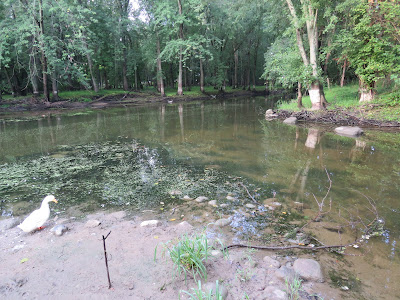The early morning temperature is in the upper 60’s, under mostly sunny skies as I pause to listen to a chorus of insects (crickets, katydids, cicadas) and a Mourning Dove while watching the water of Pine Creek flow south into the Maple River. I’m just north of Clinton County’s village of Maple Rapids to begin my quest to follow Pine Creek upstream through impounded Rainbow Lake to its source, some 14 miles north of here in Gratiot County. Scanning the ground, I catch a glimpse of a 3-inch Northern Leopard Frog, hiding in the dew-covered grass. Over the past thirty years, this species of frog has suffered dramatic population decline across its western range. Factors that contributed to this decline, include habitat loss and degradation; introduction of exotic predators, such as nonnative fish, bullfrogs and crayfish; introduction of disease and pesticides and climate change effects on aquatic habitats. Looking around, I locate both yellow blossoms of Canadian Goldenrod and green blossoms of Common Ragweed. To clarify a common misconception, it’s the light-weight, wind-blown pollen of Ragweed that is the primary allergen for those who suffer from autumn “hay fever”, not the heavier pollen of Goldenrod that rarely becomes airborne. Further upstream, I notice the creek water is stagnate and covered in duckweed. Along the lush bank, I spot orange blossoms of Jewel Weed and yellow blossoms of Jerusalem Artichoke. This plant has roots of fleshy tubers (stock photo) that are edible and taste something like nuts and artichokes. Other blossoms seen include Wild Cucumber and Pennsylvania Smartweed. These plants are called smartweed because they have a sharp, peppery flavor and their plant juice makes one’s eyes run. Considered an herb, the entire plant is used to make medicine. People take smartweed tea to stop bleeding from hemorrhoids, as well as menstrual bleeding and other uterine bleeding. They also use it to treat diarrhea. Just ahead, the edible fruit of Elderberry and the inedible fruit of Pokeweed catch my eye. Eating Pokeberries can pose a risk for birds, particularly late in the year. It seems the berries will sometimes ferment, intoxicating birds that eat them. Although all parts of Pokeweed – berries, roots, leaves and stems – are poisonous to humans, some folks take the risk of eating poke salad each spring. Continuing upstream, I come upon a patch of ¾ inch Bonnet Cap mushrooms growing on a decayed log. Although these little mushrooms are considered edible, they are quite insubstantial, certainly not highly prized and not worth collecting to eat. Approaching the car, another early sign of autumn catches my eye: Virginia Creeper leaves turning red. At the car, suddenly a Great Blue Heron flies my way, sees me, turns around and flies away.
Scenes from my weekly walk
Song of a dove, sight of a hawk
Frogs that hop, leaves that sway
Sunrise at the break of day
Muskrat swims among the reeds
Wind blows the milkweed seeds
On the ground, a garter snake
On the pond, a mallard drake
Sky above and earth below
Nature’s late summer show
D. DeGraaf

Sounds like a delightful excursion. Lots of fun information here; I have grown and enjoy Jerusalem Artichokes. Love the poem!
ReplyDelete